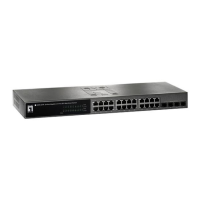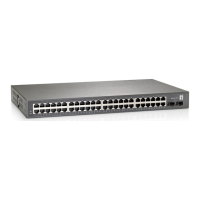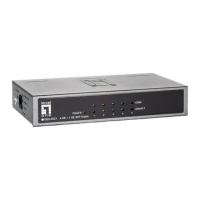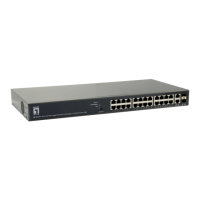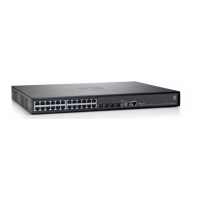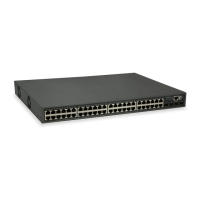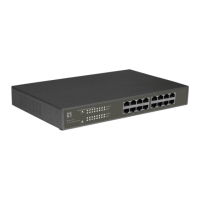Do you have a question about the LevelOne GSW-2472TGX and is the answer not in the manual?
Conforms to IEEE 802.3 standards for Ethernet, Gigabit fiber, and Flow control.
Details management, port trunk, VLAN, and QoS policy capabilities.
Lists items included in the product package.
Describes the ports and LED indicators on the front of the switch.
Explains the status and meaning of various LED indicators on the switch.
Details the power plug location and operating voltage range.
Provides instructions for placing the switch on a flat surface for optimal operation.
Guides on how to mount the switch in a standard 19-inch rack.
Instructions for connecting the power cord and verifying power supply.
Steps to connect and configure a PC for console access using RS-232.
Overview of the 8 functions available in the console management interface.
How to view the status of each port, including link, speed, and duplex.
Steps to configure individual port settings like enable, Nway, speed, and flow control.
Instructions for configuring port trunk groups, excluding gigabit ports.
Guide to creating, modifying, and deleting VLAN groups (PortBase, 802.1Q).
How to select between PortBase and 802.1Q VLAN modes.
Steps to add Port-Based VLAN groups.
Steps to add 802.1Q VLAN groups via the web interface.
How to modify VLAN group members via the web interface.
Procedure to delete unwanted VLAN groups.
Configuration of 802.1Q VLAN ingress filter settings.
Method for monitoring network traffic via mirror ports.
How to configure port priority levels for high or low queues.
Configuring inbound and outbound bandwidth rates per port.
Access to system configuration options like password, reboot, and IP settings.
Settings for broadcast storm filter, MAC table aging, and auto-logout.
Procedure to change console and web management login username and password.
Resets the switch to its default factory configuration.
How to perform a software reboot of the switch.
Displays firmware and chip version details of the switch.
Setting the switch's IP address, subnet mask, and default gateway.
Introduction to the embedded HTML website for managing the switch.
Steps to prepare for web management, including checking default IP settings.
Instructions for logging into the web management interface.
View port status, negotiation results, and auto-detect gigabit port status.
Configure individual port settings like enable, Nway, speed, and flow control via web UI.
Configure port trunk groups, excluding gigabit ports, using radio buttons.
Create, modify, delete VLAN groups (PortBase, 802.1Q) via web interface.
Steps to add Port-Based VLAN groups through the web interface.
Steps to add 802.1Q VLAN groups via the web interface.
How to modify VLAN group members via the web interface.
Procedure to delete VLAN groups by checking checkboxes.
Configure 802.1Q VLAN ingress filter settings.
Set up port monitoring modes (RX, TX, Both) and select monitored ports.
Configure QoS modes (priority levels) for incoming packets.
Configure inbound and outbound bandwidth rates per port using the web interface.
Configure broadcast storm filter, MAC table settings, and auto-logout timers.
Change web management login username and password.
Reset the switch to factory default configuration via the web interface.
Perform a software reboot of the switch through the web interface.
View firmware and chip version details of the switch.
Configure the switch's IP address, subnet mask, and default gateway.
Common issues related to incorrect or faulty cable connections.
Assisting in identifying problems by monitoring panel indicators.
Guidelines for selecting appropriate UTP/STP cables for different port types.
Steps to troubleshoot issues when the Mini GBIC module is not detected.
Details the technical specifications including standards, protocol, and transfer rate.
Conforms to IEEE 802.3 standards for Ethernet, Gigabit fiber, and Flow control.
Details management, port trunk, VLAN, and QoS policy capabilities.
Lists items included in the product package.
Describes the ports and LED indicators on the front of the switch.
Explains the status and meaning of various LED indicators on the switch.
Details the power plug location and operating voltage range.
Provides instructions for placing the switch on a flat surface for optimal operation.
Guides on how to mount the switch in a standard 19-inch rack.
Instructions for connecting the power cord and verifying power supply.
Steps to connect and configure a PC for console access using RS-232.
Overview of the 8 functions available in the console management interface.
How to view the status of each port, including link, speed, and duplex.
Steps to configure individual port settings like enable, Nway, speed, and flow control.
Instructions for configuring port trunk groups, excluding gigabit ports.
Guide to creating, modifying, and deleting VLAN groups (PortBase, 802.1Q).
How to select between PortBase and 802.1Q VLAN modes.
Steps to add Port-Based VLAN groups.
Steps to add 802.1Q VLAN groups via the web interface.
How to modify VLAN group members via the web interface.
Procedure to delete unwanted VLAN groups.
Configuration of 802.1Q VLAN ingress filter settings.
Method for monitoring network traffic via mirror ports.
How to configure port priority levels for high or low queues.
Configuring inbound and outbound bandwidth rates per port.
Access to system configuration options like password, reboot, and IP settings.
Settings for broadcast storm filter, MAC table aging, and auto-logout.
Procedure to change console and web management login username and password.
Resets the switch to its default factory configuration.
How to perform a software reboot of the switch.
Displays firmware and chip version details of the switch.
Setting the switch's IP address, subnet mask, and default gateway.
Introduction to the embedded HTML website for managing the switch.
Steps to prepare for web management, including checking default IP settings.
Instructions for logging into the web management interface.
View port status, negotiation results, and auto-detect gigabit port status.
Configure individual port settings like enable, Nway, speed, and flow control via web UI.
Configure port trunk groups, excluding gigabit ports, using radio buttons.
Create, modify, delete VLAN groups (PortBase, 802.1Q) via web interface.
Steps to add Port-Based VLAN groups through the web interface.
Steps to add 802.1Q VLAN groups via the web interface.
How to modify VLAN group members via the web interface.
Procedure to delete VLAN groups by checking checkboxes.
Configure 802.1Q VLAN ingress filter settings.
Set up port monitoring modes (RX, TX, Both) and select monitored ports.
Configure QoS modes (priority levels) for incoming packets.
Configure inbound and outbound bandwidth rates per port using the web interface.
Configure broadcast storm filter, MAC table settings, and auto-logout timers.
Change web management login username and password.
Reset the switch to factory default configuration via the web interface.
Perform a software reboot of the switch through the web interface.
View firmware and chip version details of the switch.
Configure the switch's IP address, subnet mask, and default gateway.
Common issues related to incorrect or faulty cable connections.
Assisting in identifying problems by monitoring panel indicators.
Guidelines for selecting appropriate UTP/STP cables for different port types.
Steps to troubleshoot issues when the Mini GBIC module is not detected.
Details the technical specifications including standards, protocol, and transfer rate.
| Product Type | Managed Switch |
|---|---|
| Number of Ports | 24 |
| Primary Port Type | Gigabit Ethernet |
| Form Factor | Rack-mountable |
| Layer | Layer 2+ |
| MAC Address Table Size | 8K |
| Jumbo Frame Support | Yes |
| Jumbo Frame Size | 9K |
| Dimensions | 440 x 44 mm |
| Ports | 24 x 10/100/1000Base-T, 4 x 1000Base-X SFP |
